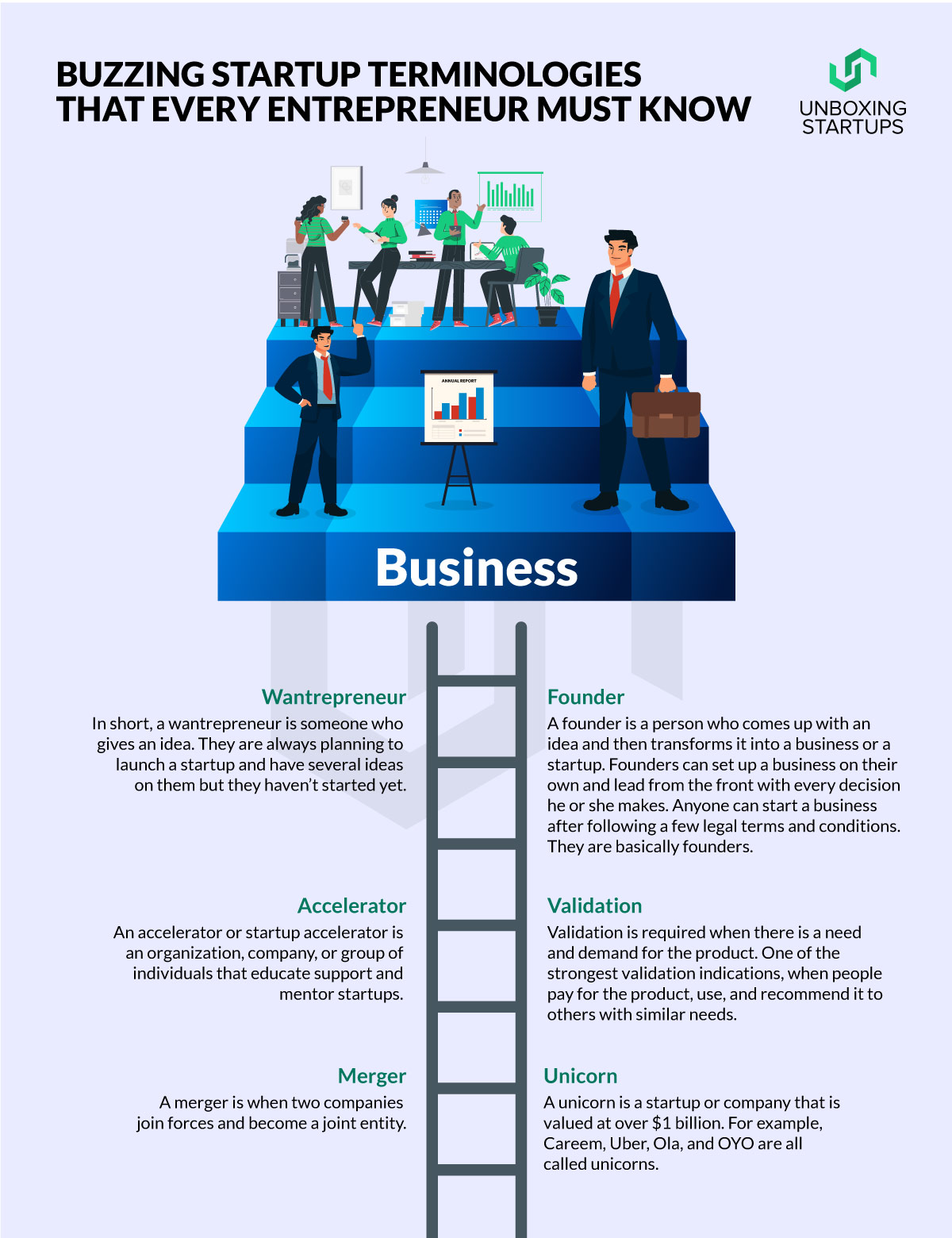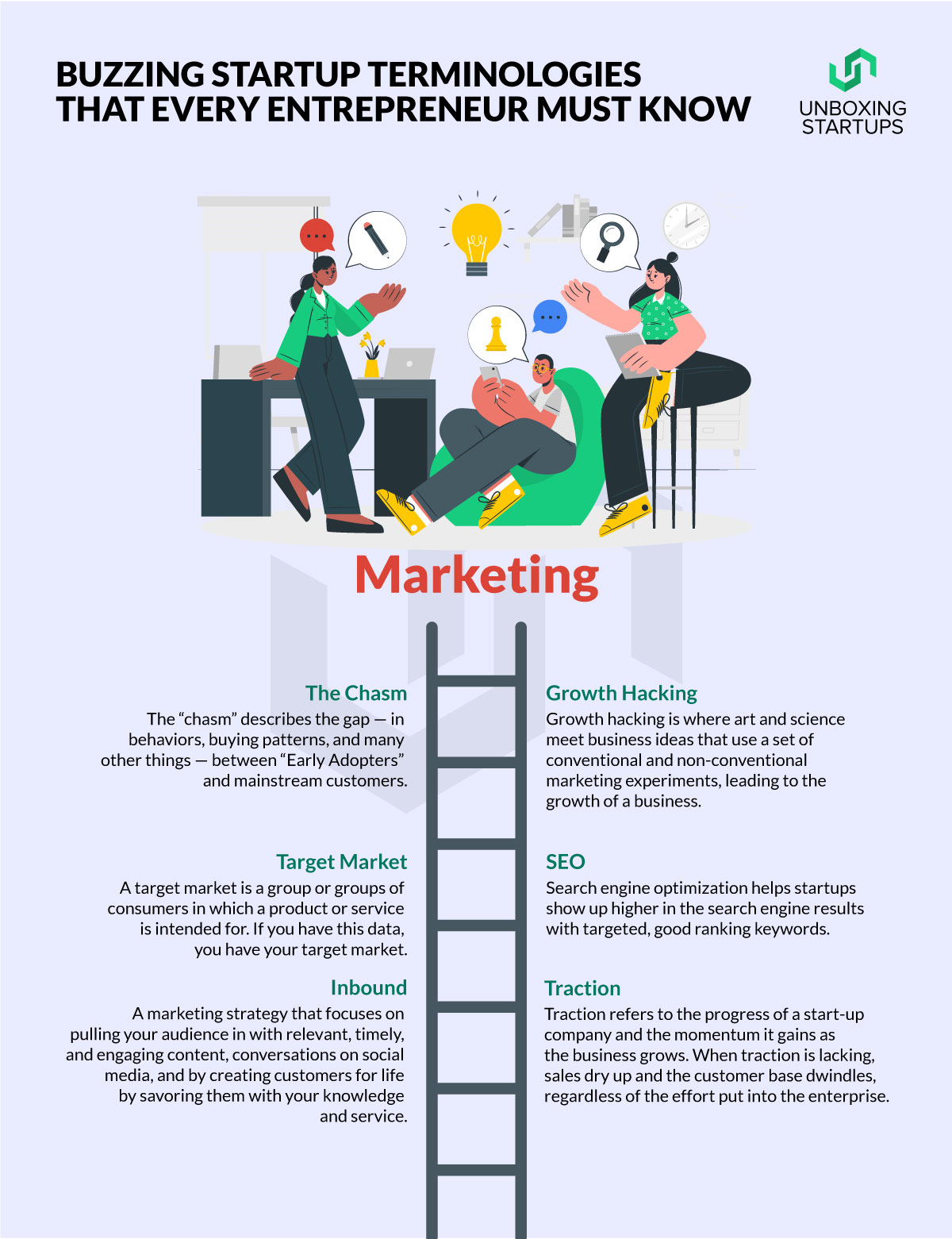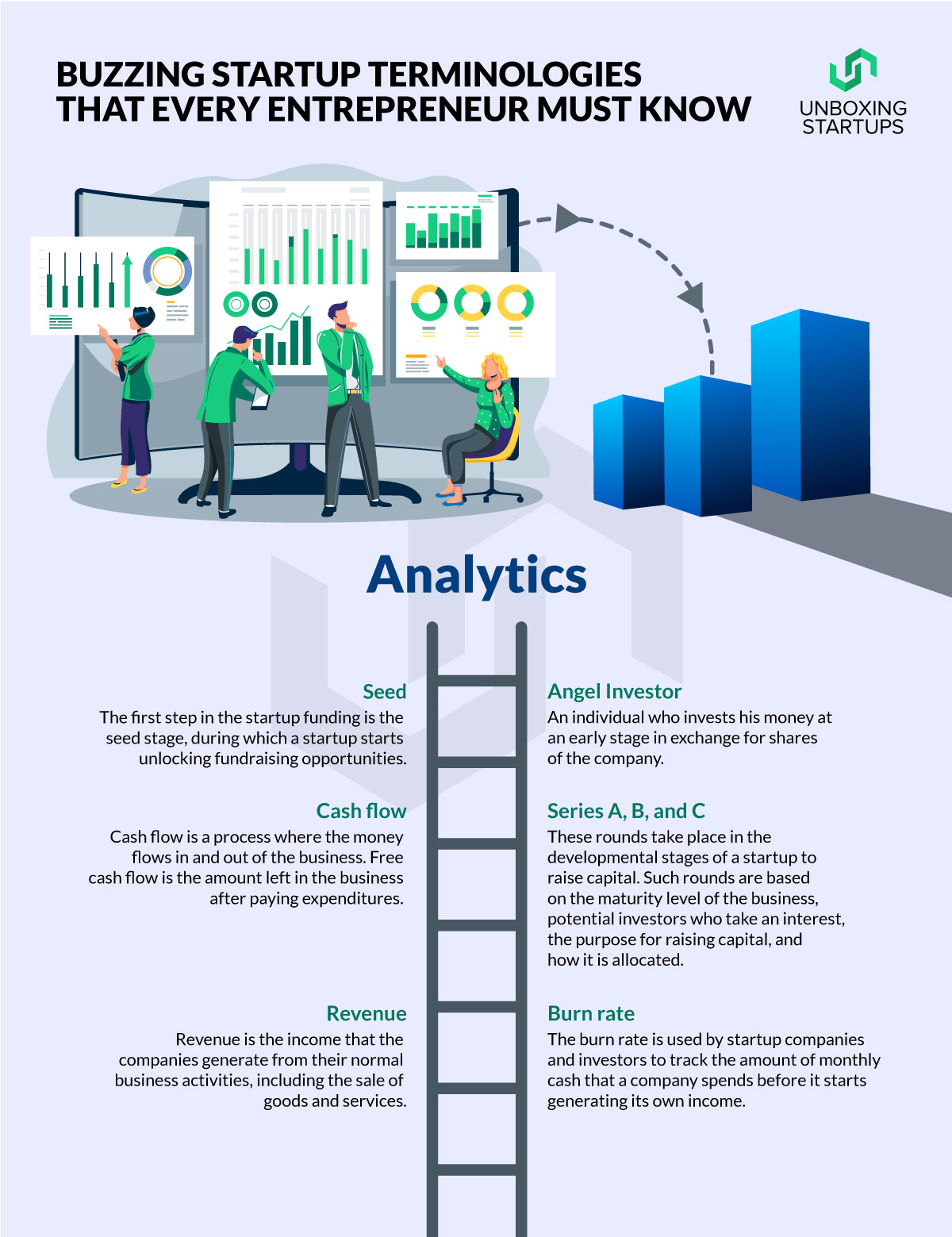
Buzzing Startup Terminologies that Every Entrepreneur Must Know
| 10 minutes read
Every time we converse with an aspiring or a new entrepreneur, we notice muddled expressions on their faces because they aren’t aware of the most commonly used startup terms. They sometimes end up making the wrong decision. We called a digital marketing professional, a wantrepreneur, two days back. As much as tried leveling up the discussion, the wearier he seemed to be. After a short delay, we decided to compile an informative list of startup terms with their meanings – resourceful to newbie startups, founders, and entrepreneurs. We are going to list Buzzing Startup Terminologies every entrepreneur must know about.
Unboxing Startups covers most of the startup terms with a brief definition for each that you can use as a reference for learning, enhancing, or remembering some of the most commonly used words in the field.
Startups Terminologies Every Entrepreneur Should Know
Business
- Founder- A founder is a person who comes up with an idea and then transforms it into a business or a startup. Founders can set up a business on their own and lead from the front with every decision they make. Anyone can start a business after following a few legal terms and conditions. They are founders.
- Wantrepreneur- In short, a wantrepreneur is someone who gives an idea. They are always planning to launch a startup and have several ideas, but they haven’t started yet.
- Non-technical- Technical founders have a programming background or have good knowledge of coding. Non-technical founders tend to be business or marketing people.
- Validation- Validation is required when there is a need and demand for the product. One of the strongest validation indications is when people pay for the product, use it and recommend it to others with similar needs.
- Scalability- How big can your business grow? How much market demand do you have? Which markets can you grow into? And one of the common questions from investors is, “How scalable is this opportunity?”. A startup is called scalable when it creates and validates a repeatable business model that addresses user needs around the clock.
- Accelerator: An accelerator or startup accelerator is an organization, company, or group of individuals that educate support and mentor startups.
- Incubators- An incubator is similar to an accelerator but there are certain differences. Apart from mentoring and providing space for work, incubators are also responsible for giving new ideas to the startups to help them grow into high-performing enterprises.
- Unicorn- An unicorn is a startup or company that is valued at over $1 billion. For example, Careem, Uber, Ola, and OYO are all called unicorns.
- Dragon- A Dragon is a startup that raises $1 billion in a single round of funds. Dragon startups aim to return the entire fund to the investors as they grow.
- Bootstrapping- It means getting into or out of a situation using your own resources. A bootstrapped business is a company without outside investment funds. Entrepreneurs refer to bootstrapping as the act of starting a business with no outside money — or, at least, very little investment. Bootstrapping means launching a business without the help of venture capital firms or even significant angel investment.
- Iteration- At the end of the day, an idea is just an educated guess. Iterate means to try something, refine it, try again, and keep trying using small steps until success.
- Pivot- The point at which a startup or company re-evaluates its model, offering, or target markets and revamps its strategy based on the experiments, records, and analysis.
- Disruption- The act of selling cheaper products or services by a business that initially reaches the less profitable customers but gradually takes over a particular industry or market. Take the example of Uber, which completely changed how people commute.
- MVP (Minimum Viable Product)- A minimum viable product is the simplest form of your product. This can be used to attract Beta users to pitch for funding.
- Lean– Lowest feasible products are part of the lean methodology, which involves going through the build-measure-learn loop that imposes the idea of building and testing quickly. Again, speed is the key factor here.
- Agile– Agile development focuses mainly on the development part of the loop and entails building incrementally and iteratively while testing rapidly.
- Exit– Exit strategy in terms of business is a strategic plan of an entrepreneur to make a profit out of the company by selling it, which will give the entrepreneur and the investors a return on their investment.
- Saas– SaaS is a subscription that is sold so that your user can use your software.
- PaaS– PaaS allows users to build, manage, and run applications without owning or operating any infrastructure.
- Acqui-hire– Acqui-hire is a strategy used to acquire talent when one company buys out another primarily for the skills and expertise of the staff.
- Alpha Release- Since Alpha testing for developers is important to the success of the software, teams run alpha tests before releasing the beta version of the product for public testing.
- Beta Release- Beta testing involves users who provide feedback and help the team make changes before the official launch.
- Board of directors- A group of experts elected by the shareholders of a startup or company to oversee the activities of a startup that includes investors and mentors. Investors typically need to invest in the company to get elected as a board member.
- Business Development- Business Development is a highly strategic function in a startup that allows you to develop hypotheses about markets/tech trends and their potential impact on your business.
- BM Canvas- Business Model Canvas is a visual representation of current or new business models, generally used by strategic managers. The Canvas provides a holistic view of the business as a whole. It is especially useful in running a comparative analysis on the impact an increase in investment may have on any contributing factors.
- Hockey Stick- It is a term used to describe a revenue growth pattern that many successful startups have achieved. It typically outlines the beginning of the startup, their first couple of years of hustling, and then their turning point. The turning point is when the company starts to grow and when there’s no turning back.
- Pitch Deck- It is a short and limited slide of PPT that covers all the aspects of your business. The deck should be compact, concise, and create a maximum impact. In addition, one should consider gaining a lot of feedback and hiring a graphic designer to make the final version look spectacular.
- Freemium- A freemium approach is when you give your basic product or service away for free and then try to upsell other features to your customers. It is a common and proven technique to acquire more users.
- Value proposition- Value proposition refers to that one unique feature of your business, product, or service that benefits consumers or users.
- Consumer products- Products created and made for consumers’ usage are known as consumer products. For instance, Samsung sells a phone, which is a consumer product.
- Enterprise products- Like consumer products, companies also use and utilize enterprise products.
- Competitive advantage– When one company differentiates from its competitors through innovation, intellectual property, exclusive rights, and partnerships, it is known as a competitive advantage.
- Customer development– Customer development is the stage during which you discover and validate the customer mainly by interviewing them.
- Product/Market fit- Essentially, you reach product/market fit when your customer acquisition cost is lower than the lifetime value of your customers.
- Merger- A merger is when two companies join forces and become a joint entity.
- Acquisition- The state of taking over a startup or business by another company by purchasing its shares or assets.
- Convertible note– A convertible note is a form of short-term debt that converts into equity, typically in conjunction with a future financing round. In effect, the investor would be loaning money to a startup. However, instead of a return in principal plus interest, the investor would receive equity in the company.
- Non Disclosure Agreement (NDA)- A legal document meant to protect a company or startup’s essential and crucial information such as proprietary code, formulas, strategies, data, or customer information.
- Venture Capitalist- A high net worth individual who invests money in businesses in exchange for an equity share of the company. Here, an investment firm is usually at the center stage, and pools in the money from high net worth individuals or large enterprises looking to invest their capital into new startups.
- B2B- B2B refers to companies that sell a product or service to another company, rather than (or in addition to) individual consumers.
- B2C- B2C refers to the process of selling products and services directly between a business and consumers who are the end-users of its products or services.
- Bubble- A bubble describes a situation in an economic cycle where a company does not realize that it might be overvalued and over-inflated.
- Churn rate- The churn rate is the annual percentage rate when customers stop subscribing to a service or employees leave a job. It is the percentage of users who stop using an app within a given period. For an app to grow, the number of new users must be higher than the number of users who leave.
- Copyright- Usually used in the technical and creative industries, copyrights protect your music, art, and films. It allows the creator to have exclusive rights for its use and distribution. Overall it gives value to your work.
- Ecosystem- It consists of a group of people, startups, and related organizations that work as a system to create and scale new startups. Startup ecosystems are formed often in a relatively limited area with a center of gravity like a university or a concentration of technology companies.
- Evangelist- An evangelist is someone inside your organization who is your biggest fan. Hire them if you find them.
- Intellectual Property– A invention that is protected through patents, copyrights, trademarks, or others. An IP can be a patent or a secret sauce or formula like KFC spices. It is a creation of such an invention, artistic work, design, symbol, name, and images used in commerce.
- Leverage– Leverage involves using capital (assets), usually cash from loans to fund company growth and development in a similar way, through the purchase of assets. Such growth cannot be accomplished without the benefit of additional funds gained through leverage.
- LTV(Lifetime Value) – Stands for the lifetime value of the customer. The basic formula to calculate LTV is multiplying the average revenue per account by gross margin and dividing the total by customer churn rate. Today, many platforms can help you calculate and project your LTV.
- Cost to acquire customers– One of the most critical metrics in business is customer acquisition cost. In other words, how much does it cost you to acquire a customer? It is hard to budget marketing campaigns or make projections without knowing these numbers.
Marketing
- Growth Hacking- Growth hacking is where art and science meet business ideas that use a set of conventional and non-conventional marketing experiments, leading to business growth.
- The Chasm- The “chasm” describes the gap — in behaviors, buying patterns, and many other things — between “Early Adopters” and mainstream customers.
- SEO- Search engine optimization helps startups show up higher in the search engine results with targeted, good ranking keywords.
- Target Market– A target market is a group or groups of consumers in which a product or service is intended for. If you have this data, you have your target market.
- Traction- Traction refers to the progress of a start-up company and the momentum it gains as the business grows. When traction is lacking, sales dry up, and the customer base dwindles, regardless of the effort put into the enterprise.
- Inbound– A marketing strategy that focuses on pulling your audience in with relevant, timely, and engaging content, conversations on social media, and by creating customers for life by savoring them with your knowledge and service.
- Outbound– Outbound marketing requires a financial commitment as it involves paying attention to platforms like Facebook, Google, and LinkedIn to push your product to the customer.
- Public Relations- Public relation simply means maintaining the image of your company in the public domain. And startups focus on new strategies in marketing and advertising to attract potential customers. They create media, from press releases to social media messages, that shape the company’s public opinion and create brand awareness.
Analytics
- Angel Investor- An individual who invests his money at an early stage in exchange for shares of the company.
- Seed- The first step in the startup funding is the seed stage, during which a startup starts unlocking fundraising opportunities.
- Series A, B, and C- These rounds take place in the developmental stages of a startup to raise capital. Such rounds are based on the maturity level of the business, potential investors who take an interest, the purpose for raising capital, and how it is allocated.
- Cash flow- Cash flow is a process where the money flows in and out of the business. Free cash flow is the amount left in the business after paying expenditures.
- Pre-Money Valuation- It refers to the company’s value before any external funding. Usually, pre-money valuation companies are estimated at how much they might be worth before they get external income or start receiving the investment.
- Post-money valuation- The value of a startup either increases or decreases after a round of funding. It decreases if the new funding round puts a lower valuation on the startup than it was worth before getting funded. Although, in most cases, investors fund a venture to increase the valuation, and thus we often see the value of a startup after funding, post-money valuation, higher than in previous rounds.
- Burn rate-Startup companies, and investors use the burn rates to track the amount of monthly cash that a company spends before it starts generating its own income.
- Cap table- It is a chart, generally used by startups to show ownership stakes, or how much investors are paid in the business. All the crucial calculations in the business in terms of the ownership share and other information about the company’s securities come under the cap table.
- Crowdfunding- Crowdfunding is a process of funding a project by raising some amount of money from an individual or a large number of people. Crowdfunding is possible when you have a good reputation in the market, and people will take an interest in funding your startup.
- ROI- ROI stands for Return on Investment. It can be described as the performance measure used to evaluate the efficiency of an investment or compare the efficiency of a number of different assets.
- Term Sheet- A term sheet is a non-binding document that lays out the proposed terms and conditions under which an investor will make an equity investment in a startup.
- Sweat equity- It is a non-monetary contribution that the individuals or founders of a company make towards the company. Cash strapped start-ups and business owners generally use sweat equity to fund their companies.
- Run Rate– It is a method of forecasting upcoming earnings over a longer time period (usually one year) based on past earnings data. Run rate lets you estimate how much revenue you might expect from your SaaS company throughout the next year.
- Revenue– Revenue is the companies’ income from their normal business activities, including the sale of goods and services.
- Vesting- A process that involves giving or earning a right to a present or future payment, benefit, or asset. In order to ensure investors’ and employees’ long-term commitment to the startup, vesting schedules require stockholders’ involvement in the startup for a predetermined period, usually 3-4 years, before they claim their shares.
- Cliff- A cliff is used to require stockholders to remain with the startup, usually for at least 1 year, before they can claim a percentage of their shares. Cliffs can be a device for the CEO to fire employees or let them leave without giving them stock within a limited period.

Born in the family of entrepreneurs and have inherited the same. Started building applications in order to pay for my tuition. Later founded a tech company, marketing agency, and media outlets.







